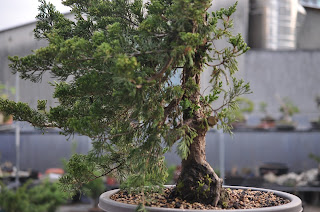It has been 3 years and 3 months since I planted these cuttings into the ground. To give you a better idea of the size, that is a chop stick supporting the cutting.
 |
| 3.3 years ago. |
 |
| Below are more pictures of these finer roots growing from where we cut a year ago. |
 |
| I put these guys into a plastic bag and brought them to my roof top. This is where the potential damage can occur. I have changed the entire environment for these trees. They grew up on the mountain and now they find themselves down the hill on top of an apartment. I need to be careful. I need to put them in good soil, secure them into a pot, and remove some branches. I want to prune some larger branches and reduce the amount to foliage. By removing some branches and leaves this will hopefully reduce the work load of the roots to supply water to these parts. I also don't want these branches - I want to create an old looking bonsai tree that has endured hardship. |
 |
| I prepare the soil. Granular soil from the same mountain these trees grew up in and also river sand mixed in. |
 |
| Before venturing up the mountain I visited a local bonsai garden supply area. Most things were closed but I was lucky to find an old woman just opening up her shop the minute I arrived. I bought these pots because they were the best available. I would have preferred a different shape and possibly a little larger in size. I first put some plastic drainage mesh on the bottom of each training pot. This will stop the soil from filtering out the smaller holes. |
 |
| I also poked up some wire through these holes. I want to secure the tree in the pot. It is important for the tree to be still and not be swaying around in the breeze. The tree will not survive if this happens. |
 |
| I wanted to make this process as efficient as I could make it. I am not an efficient person but with a little planning the operation moved at a faster speed. It was 4 o'clock and I wanted to get them into their pot quickly. I was conscious of the roots drying out in that bag. |
 |
| BANG - I worked like a mad man, Got them all in and secured in their pot. |
 |
| This one wasn't actually a cutting. We planted a mother tree to look after her cuttings 3 years ago. This girl has thickened nicely as well. |
 |
| Some closer pictures of a few of them in their new house. |
 |
| A healthy watering to make the union complete. |
 |
| Number 1 before first trimming. The next morning I set about pruning the longer branches. I had some rough design ideas in my mind as I did this. |
 |
| Number 1 after first trimming. Minor wiring of the 2 branches. |
 |
| Number 2 before first trimming. |
 |
| Number 2 after first trimming. Needed to open the tree up a bit. |
 |
| Number 3 before first trimming. |
 |
| Number 3 after first trimming. |
 |
| Number 4 before first trimming. |
 |
| I went back and looked at that left branch jutting off to the left. I ended up reducing it and decided to make it into a jin. I thought it was too large to have as a side branch so high up on the tree. |
 |
| Number 4 after first trimming. |
 |
| Number 5 before first trimming. |
 |
| Number 5 after first trimming. I got adventurous with this one. I think it is important to sometimes take a risk and see what your material can do. You can read volumes of books but actually doing the real thing is what it is about. Having lots of trees to work with is also key. If this was my only tree then I'm not sure I would have removed so much foliage. Slowly build up your collection of trees and push a few - choose the right season though and make sure the tree is healthy in the first place. This particular tree, before trimming, was at the peak of its health. It was growing for 3 years on a mountain and was full of energy. I believe my severe pruning was a calculated risk. |
 |
| Number 6 before first trimming. |
 |
| Number 6 after first trimming. |
 |
| Number 7 before first trimming. |
 |
| Number 7 after first trimming. I feel like this tree could be really nice in the future. |
 |
| Number 8 before first trimming. |
 |
| Number 8 after first trimming. Did some wiring to work some movement into the new apex. |
 |
| Carnage. |
 | ||
The left overs from the 8 trees. I could have used all these as cuttings but I decided not to. If I had a bigger place then that is what I would have done.
|







Wow, what a lot of work! I was intrigued to see the growth and development of these trees, even a relatively short time after their re-planting. They've certainly developed a lot since those tiny "chopstick" days!
ReplyDeleteYou definitely got stuck into a few of these trees, especially poor old number 5: I take your point though....there's no need to be conservative with all of them and you may discover something as you go, good or bad.
Great pic of the family too! Now, just one last question......where's that #@$%ing spade?!